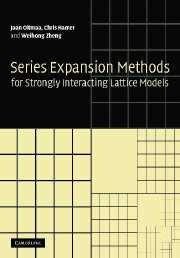Book contents
- Frontmatter
- Contents
- Preface
- 1 Introduction
- 2 High- and low-temperature expansions for the Ising model
- 3 Models with continuous symmetry and the free graph expansion
- 4 Quantum spin models at T = 0
- 5 Quantum antiferromagnets at T = 0
- 6 Correlators, dynamical structure factors and multi-particle excitations
- 7 Quantum spin models at finite temperature
- 8 Electronic models
- 9 Review of lattice gauge theory
- 10 Series expansions for lattice gauge models
- 11 Additional topics
- Appendix 1 Some graph theory ideas
- Appendix 2 The ‘pegs in holes’ algorithm
- Appendix 3 Free graph expansion technicalities
- Appendix 4 Matrix perturbation theory
- Appendix 5 Matrix block diagonalization
- Appendix 6 The moment–cumulant expansion
- Appendix 7 Integral equation approach to the two-particle Schrödinger equation
- Appendix 8 Correspondences between field theory and statistical mechanics
- Appendix 9 Computer programs
- Bibliography
- Index
6 - Correlators, dynamical structure factors and multi-particle excitations
Published online by Cambridge University Press: 06 January 2010
- Frontmatter
- Contents
- Preface
- 1 Introduction
- 2 High- and low-temperature expansions for the Ising model
- 3 Models with continuous symmetry and the free graph expansion
- 4 Quantum spin models at T = 0
- 5 Quantum antiferromagnets at T = 0
- 6 Correlators, dynamical structure factors and multi-particle excitations
- 7 Quantum spin models at finite temperature
- 8 Electronic models
- 9 Review of lattice gauge theory
- 10 Series expansions for lattice gauge models
- 11 Additional topics
- Appendix 1 Some graph theory ideas
- Appendix 2 The ‘pegs in holes’ algorithm
- Appendix 3 Free graph expansion technicalities
- Appendix 4 Matrix perturbation theory
- Appendix 5 Matrix block diagonalization
- Appendix 6 The moment–cumulant expansion
- Appendix 7 Integral equation approach to the two-particle Schrödinger equation
- Appendix 8 Correspondences between field theory and statistical mechanics
- Appendix 9 Computer programs
- Bibliography
- Index
Summary
Introduction
In the previous chapters we showed how series expansion methods can be used to study ground state properties and elementary excitations in simple (and not so simple) antiferromagnets. In the present chapter we extend this to a consideration of more complex properties. We begin by discussing various spin-spin correlation functions, or ‘correlators’. These play an important role in characterizing the nature of the ground state and, as we shall show, can be used to locate quantum phase transition points. The correlators can be combined to form the dynamical twospin structure factors S(k, ω), which are measured in inelastic neutron scattering experiments. We will discuss how these can be computed via series methods, and show some results for the integrated (static) forms.
While one-particle excited states are usually the dominant excitations in quantum systems, there are situations in which two-particle excitations, including bound states, and more general multi-particle excitations also play an important role. There are a number of experimental probes which are beginning to show features associated with multi-particle continuum and bound states, including two-magnon Raman spectroscopy, photo-emission and inelastic neutron scattering. For example, Tennant et al. (2003) have measured two-magnon states in copper nitrate, a quasi one-dimensional antiferromagnet (see Section 6.4.4). Thus one can hope to build up a detailed picture of the dynamics of these quasiparticle excitations, and to construct an effective Hamiltonian to describe them. In the last part of the chapter we outline how one may calculate series expansions for the spectrum of multi-particle excitations in a quantum lattice model at T = 0.
- Type
- Chapter
- Information
- Series Expansion Methods for Strongly Interacting Lattice Models , pp. 124 - 149Publisher: Cambridge University PressPrint publication year: 2006

